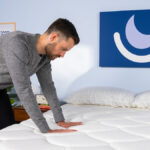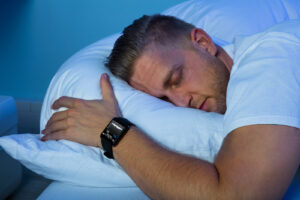Actigraphy is a way of tracking sleep that involves wearing a monitor similar to a wristwatch. Because actigraphy can estimate important details like when you’re asleep or awake, this type of test offers a convenient and reliable method of identifying certain sleep problems and how a person responds to treatment for sleep-related issues.
We cover how actigraphy works and what to expect if a doctor has recommended an actigraphy test. We also cover how actigraphy devices prescribed by doctors differ from sleep trackers and apps found on a phone or smartwatch.
What Is Actigraphy?
Actigraphy is a wearable device that monitors movement to identify sleep and wake patterns. While a person is wearing an actigraphy device, it collects data that can help doctors diagnose certain sleep disorders. Actigraphy can also help determine if a prescribed treatment for certain sleep problems is effective.
Actigraphy has been used in sleep medicine for many years. A key feature of actigraphy is that it can be conducted in the comfort of a person’s own home, making it more convenient than other sleep tests while offering a more realistic representation of a typical sleep/wake patterns and sleep habits.
How Actigraphy Works
In actigraphy, a small device is typically worn on the wrist and monitors movement and, in some devices, exposure to light and darkness in the person’s environment. At the same time, a person is instructed on how to keep a written actigraphy log, in which certain data is tracked by hand to increase the accuracy of actigraphy results.
Using both the data collected by the actigraphy device and the written actigraphy log, the device’s software provides insight into the person’s rest and activity patterns. including:
- How active a person is during the day
- How long it takes to fall asleep
- The amount of time spent sleeping
- The frequency and length of nighttime awakenings
Does Actigraphy Diagnose Sleep Disorders?
Actigraphy may help doctors detect and monitor a variety of sleep issues. Most often, actigraphy is to help diagnose circadian rhythm sleep disorders. These sleep problems occur when the body’s circadian rhythms become misaligned, such as in shift work disorder and jet lag. Actigraphy helps doctors understand the timing of a person’s circadian patterns.
Actigraphy may also be used to determine if a lack of sleep is the cause of excessive daytime sleepiness. This can help doctors evaluate people suspected of having hypersomnia or other central disorders of hypersomnolence. In these cases, actigraphy may be used to ensure that people get sufficient sleep before another type of sleep test called a multiple sleep latency test.
Although actigraphy is not necessary for diagnosing obstructive sleep apnea, it may be used as part of some at-home sleep apnea tests. In these cases, actigraphy helps the testing device determine whether a person is awake or asleep.
By tracking a person’s sleep and wake patterns, actigraphy can also be used to monitor a person’s response to treatment for sleep problems. For example, people making improvements in their sleep hygiene may see the results of their efforts reflected on actigraphy.
Actigraphy vs. Other Ways of Tracking Sleep
Other ways of understanding sleep include sleep studies, sleep trackers, and self-reported sleep diaries. Each of these tests has an important place in sleep medicine.
Sleep Studies
Also called polysomnography, an overnight sleep study is used to diagnose a wide range of sleep disorders. Depending on the reason for ordering the test, a sleep study may be conducted in a person’s home or within a specialized sleep lab. Actigraphy is a standard part of some at-home sleep studies.
During in-lab sleep studies, a person is hooked up to computerized devices that monitor a wide range of body functions during sleep. Compared to actigraphy, a sleep study measures more variables, like breathing patterns and movements during sleep. Sleep studies are also more accurate in determining sleep stages.
Actigraphy does offer some advantages when compared to an in-lab sleep study. Measuring sleep in a person’s home may offer a clearer picture into a person’s normal sleep habits. Additionally, actigraphy allows sleep to be monitored over a longer period of time than a sleep study, which is helpful when extended monitoring is needed.
Sleep Trackers
There are a variety of wearable and smartphone-based sleep trackers, many of which advertise the ability to track time spent asleep and monitor sleep stages. These devices are different from medical grade actigraphy devices prescribed by a doctor. While sleep trackers may offer some insight into sleep health, they can overestimate total sleep time and are not used to diagnose or treat sleep disorders.
Sleep Diaries
Another way of tracking sleep is by using a sleep diary. A sleep diary is a record of daily routines that can help doctors assess and monitor sleep problems, usually for one to two weeks. A sleep diary may reveal important information about sleep habits, but it has some drawbacks, especially when used alone.
It can be challenging for people to accurately recall their sleep habits, so sleep diaries may not be precise. For example, people with insomnia may spend a significant amount of time in bed but misjudge how much time they are actually sleeping. Additionally, not everyone is capable of completing a sleep diary, including children and people with cognitive difficulties.
Experts do recommend that people record sleep-related habits when using an actigraphy device. An actigraphy log is similar to a sleep diary, but written in a format that can be combined with the data from the actigraphy device. Together, an actigraphy device and actigraphy log can give a more accurate picture of a person’s sleep.
What to Expect with an Actigraphy Test
If a doctor has recommended actigraphy, they will provide instructions on how to use the device. An actigraphy device is usually worn on the nondominant wrist for several days or weeks. The small, lightweight device doesn’t usually impact daily activities or sleep. If taken off for any reason, it should be put back on as soon as possible.
There may be some slight variations with features between actigraphy devices. Many have buttons that can be pressed to note bedtimes and other events. Some also have light sensors that should not be covered up by clothing. Most devices need to be programmed by a doctor and charged before use.
The doctor will also give instructions for keeping a log of sleep and other activities that can provide additional clues about sleep problems. An actigraphy log requires recording certain data by hand, including:
- Sleep and wake times
- How long it takes to fall asleep
- Nighttime awakenings and overall sleep quality
- Daytime naps and other activities
After actigraphy is complete, a doctor will review the data collected from the actigraphy device and the hand-written log. The results of actigraphy can help the doctor understand sleep issues, make treatment decisions, and monitor a person’s response to treatment.
References
Ask the Sleep Doctor
Have questions about sleep? Submit them here! We use your questions to help us decide topics for articles, videos, and newsletters. We try to answer as many questions as possible. You can also send us an email. Please note, we cannot provide specific medical advice, and always recommend you contact your doctor for any medical matters.


